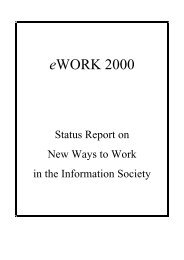Proceedings of 8th European Assembly on telework (Telework2001)
Proceedings of 8th European Assembly on telework (Telework2001)
Proceedings of 8th European Assembly on telework (Telework2001)
You also want an ePaper? Increase the reach of your titles
YUMPU automatically turns print PDFs into web optimized ePapers that Google loves.
193Introducti<strong>on</strong>The <strong>on</strong>going ec<strong>on</strong>omic and social change, which is <str<strong>on</strong>g>of</str<strong>on</strong>g>ten referred to as the transiti<strong>on</strong> to aknowledge-based ec<strong>on</strong>omy, generates several new challenges. These challenges are c<strong>on</strong>fr<strong>on</strong>ted bynot <strong>on</strong>ly companies and individuals, governments, labour market organisati<strong>on</strong>s (social partners),and researchers are also faced with these new questi<strong>on</strong>s and must find suitable answers andsoluti<strong>on</strong>s. Three major aspects define the changes:• knowledge is becoming the driving force for productivity and an increasingly important factor<str<strong>on</strong>g>of</str<strong>on</strong>g> producti<strong>on</strong>,• new ways <str<strong>on</strong>g>of</str<strong>on</strong>g> work are emerging which affect all <str<strong>on</strong>g>of</str<strong>on</strong>g> its dimensi<strong>on</strong>s, e.g. working time, workplace, work c<strong>on</strong>tract and the c<strong>on</strong>tent <str<strong>on</strong>g>of</str<strong>on</strong>g> the work.• human resources are becoming a crucial factor in achieving competitive advantages inknowledge-intense industries.At the same time a selecti<strong>on</strong> process seems to occur. It is the divide between employees who areable to apply and utilise knowledge and those who have insufficient or no capabilities in this field.A shortage <str<strong>on</strong>g>of</str<strong>on</strong>g> skilled labour <strong>on</strong> <strong>on</strong>e hand and discriminati<strong>on</strong> or high unemployment rates <strong>on</strong> theother hand reflect this development.Some great hopes as well as many open questi<strong>on</strong>s and challenges are c<strong>on</strong>nected with the process<str<strong>on</strong>g>of</str<strong>on</strong>g> developing into a knowledge-based ec<strong>on</strong>omy.Let’s start with the hopes:Networking structures stand as the metaphor for the new organisati<strong>on</strong>s <str<strong>on</strong>g>of</str<strong>on</strong>g> the knowledge-basedsociety. On the <strong>on</strong>e hand they seem to promise unlimited diversity and possibilities to expandour horiz<strong>on</strong>s for thinking and working. At the same time the inflexible, traditi<strong>on</strong>al structures <str<strong>on</strong>g>of</str<strong>on</strong>g>instituti<strong>on</strong>s and regulati<strong>on</strong>s are cracking open. A quite obvious example for this phenomen<strong>on</strong> isthat while business and work organisati<strong>on</strong>s become open and distributed, the accompanying legalframework is still based <strong>on</strong> the expectati<strong>on</strong> <str<strong>on</strong>g>of</str<strong>on</strong>g> permanent business and workplaces.Networking makes barriers permeable or even disappear not <strong>on</strong>ly within but also betweenorganisati<strong>on</strong>s. More openness and transparency are the result. For companies the relati<strong>on</strong>shipbetween partners, customers, suppliers etc. becomes more direct. Therefore the traditi<strong>on</strong>alorganisati<strong>on</strong>al structures and hierarchical functi<strong>on</strong>s become dysfuncti<strong>on</strong>al and can now presentsevere obstacles.The new organisati<strong>on</strong>al structures are promising and demanding more aut<strong>on</strong>omy for employees.The applicati<strong>on</strong> <str<strong>on</strong>g>of</str<strong>on</strong>g> informati<strong>on</strong> and communicati<strong>on</strong>s technologies (ICT) are expected to makework easier in producti<strong>on</strong> as well as in <str<strong>on</strong>g>of</str<strong>on</strong>g>fices. They might even lead to new ways <str<strong>on</strong>g>of</str<strong>on</strong>g> work or acompletely new definiti<strong>on</strong> <str<strong>on</strong>g>of</str<strong>on</strong>g> work.In order to make some <str<strong>on</strong>g>of</str<strong>on</strong>g> these hopes come true, we must grapple with many open questi<strong>on</strong>s andchallenges:








